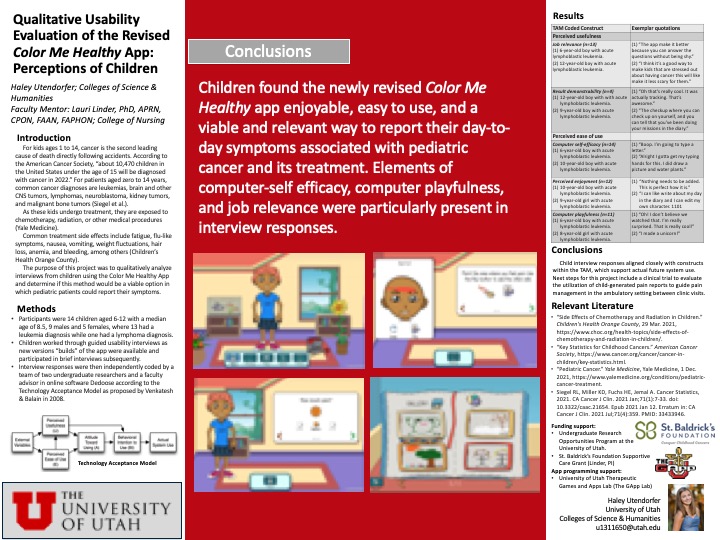Presenter Name: Haley Utendorfer
Description
Introduction:
Through qualitative analysis of patient and parent transcripts, I have, in conjunction with Dr. Lauri Linder, gauged user reactions to novel technology in the form of an app titled Color Me Healthy, which was designed by the University of Utah's Therapeutic Games and Apps Lab (The GApp Lab) to report pediatric cancer treatment symptoms. Stemming from the idea that children may often feel fatigue from conversing with doctors, nurses, and other healthcare workers almost constantly concerning their symptoms, an app would give them an avenue in which to relay their feelings electronically and create a consolidated area in which these reports can be viewed. Methods:
The purpose of this project is to summarize constructs from the Technology Acceptance Model reflected in statements by children with cancer who evaluated the revised Color Me Healthy app.
Participants were 14 children 6-12 years of age (median 8.5 years) who participated in guided usability interviews ranging from 10 to 29 minutes (median 18.5 minutes). Interviews were transcribed and uploaded to Dedoose software for qualitative coding. An a priori coding process was used based on constructs defined in the Technology Acceptance Model. Initial coding of interviews was completed independently by three individuals with each ""blinded"" to the others' coding. The group then met together to review and discuss responses and reach consensus. For my presentation, I will be focusing on the child perspective of these interviews. Results:
Interim analyses of 7 interviews are complete. Discussion:
For this project, researchers have implemented qualitative coding protocol describing Technology Acceptance Model constructs to statements from 14 children with cancer and their parents from guided usability interviews with the goal of determining necessary revisions to the app. Then, we began analyzing uploaded data with Dedoose software via a priori coding process, which is based on constructs and definitions set forth in the Technology Acceptance Model (TAM) as proposed by Venkatesh & Balain 2008. Initial coding of three child and parent interviews were completed independently with each individual ""blinded"" to other coding. Then, we have calculated Cohen's kappa to evaluate inter-rater reliability after each three child and three parent interviews with the goal of achieving kappa ≥ 0.75. For constructs with kappa < 0.75, we gathered and talked through our logic to reach a consensus.
At this point in time, we are currently halfway through analysis of all transcripts. Thus far, qualitative statements point towards the conclusion that both parents and children enjoy the app and find it relevant to the treatment they are receiving. As we finalize analysis this fall, we will prepare to effectively communicate the implications of our findings in order to improve upon the Color Me Healthy app and prepare it for clinical application.
Through qualitative analysis of patient and parent transcripts, I have, in conjunction with Dr. Lauri Linder, gauged user reactions to novel technology in the form of an app titled Color Me Healthy, which was designed by the University of Utah's Therapeutic Games and Apps Lab (The GApp Lab) to report pediatric cancer treatment symptoms. Stemming from the idea that children may often feel fatigue from conversing with doctors, nurses, and other healthcare workers almost constantly concerning their symptoms, an app would give them an avenue in which to relay their feelings electronically and create a consolidated area in which these reports can be viewed. Methods:
The purpose of this project is to summarize constructs from the Technology Acceptance Model reflected in statements by children with cancer who evaluated the revised Color Me Healthy app.
Participants were 14 children 6-12 years of age (median 8.5 years) who participated in guided usability interviews ranging from 10 to 29 minutes (median 18.5 minutes). Interviews were transcribed and uploaded to Dedoose software for qualitative coding. An a priori coding process was used based on constructs defined in the Technology Acceptance Model. Initial coding of interviews was completed independently by three individuals with each ""blinded"" to the others' coding. The group then met together to review and discuss responses and reach consensus. For my presentation, I will be focusing on the child perspective of these interviews. Results:
Interim analyses of 7 interviews are complete. Discussion:
For this project, researchers have implemented qualitative coding protocol describing Technology Acceptance Model constructs to statements from 14 children with cancer and their parents from guided usability interviews with the goal of determining necessary revisions to the app. Then, we began analyzing uploaded data with Dedoose software via a priori coding process, which is based on constructs and definitions set forth in the Technology Acceptance Model (TAM) as proposed by Venkatesh & Balain 2008. Initial coding of three child and parent interviews were completed independently with each individual ""blinded"" to other coding. Then, we have calculated Cohen's kappa to evaluate inter-rater reliability after each three child and three parent interviews with the goal of achieving kappa ≥ 0.75. For constructs with kappa < 0.75, we gathered and talked through our logic to reach a consensus.
At this point in time, we are currently halfway through analysis of all transcripts. Thus far, qualitative statements point towards the conclusion that both parents and children enjoy the app and find it relevant to the treatment they are receiving. As we finalize analysis this fall, we will prepare to effectively communicate the implications of our findings in order to improve upon the Color Me Healthy app and prepare it for clinical application.
University / Institution: University of Utah
Type: Poster
Format: In Person
Presentation #D51
SESSION D (3:30-5:00PM)
Area of Research: Nursing
Email: hutendorfer@gmail.com
Faculty Mentor: Lauri Linder

